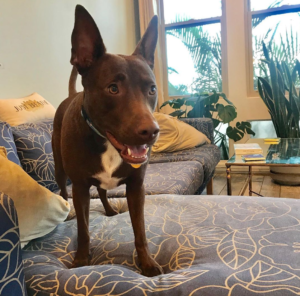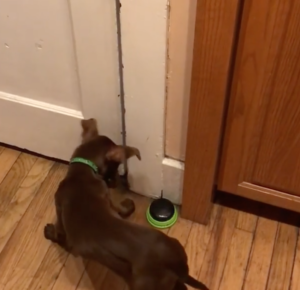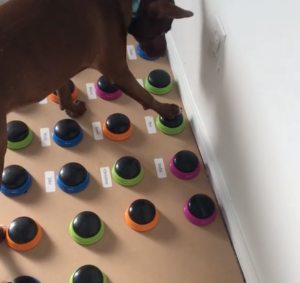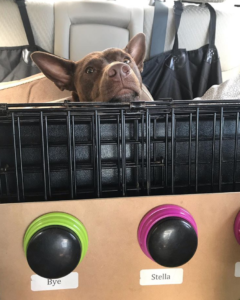Speech pathologist taught her dog how to use a soundboard – dog starts to spell full sentences

Using a unique tool, a speech therapist taught her dog how to communicate. Stella is now able to express her demands and her opinions to her parents.
What do you suppose your dog would say if it could talk? Christina Hunger, MA, CCC-SLP, a speech therapist, made the decision to investigate. Stella, her dog, now knows 29 words and is even able to speak in phrases.
Hunger, 26, trained her 18-month-old puppy to use a unique AAC system. These tools are frequently used with non-verbal kids who can express themselves by pressing one of the countless icons that represent various words. When users press the button, the device speaks the word aloud so that other people may hear it.
Hunger considered how the Catahoula/Blue Heeler mix would utilize a similar device to “speak” by pressing buttons when Hunger and her fiancé adopted a puppy last year. So, when Stella was just 8 weeks old, she started teaching her how to use an AAC.

She explained in a blog article that vocal conversation, gestures, facial expressions, writing, etc. are all forms of communication that we all use. That implies that in order to communicate ourselves, we don’t always need to be able to speak.
Dogs can express themselves through barking, whining, growling, jumping, sighing, and other behaviors. What would happen if we provided canines a method to access the words we say to them every day, Hunger thought to herself?
Hunger examined the hypothesis that dogs may communicate back using the same words via the ACC since they can understand and react to verbal cues from humans.
Hunger and Jake’s conversation began with a beloved term that almost all dogs are familiar with: outside.
Then they created a button that, when pressed, spoke the word aloud. They would press the button every time they called “outside” and let Stella out the door in the hopes that she would eventually learn to do the same whenever she wanted or needed to leave.

After a few weeks of modeling, Stella proved to us that she was conscious of the situation. I used to inquire, “Is it outside? Do you want to go outside, Stella? She started barking as she looked up at me, down at the button, and both directions.
Then they added more phrases Stella could need to express herself, like “food,” “drink,” “play,” “walk,” “no,” “come,” “help,” “bye,” and “love you.”
We replied to Stella’s communication by noticing her message and responding appropriately rather than rewarding her with a treat for pressing a button. Just like our own, Stella’s voice and ideas are important.
Eventually, Stella didn’t need cues from humans in order to use her buttons.

Hunger stated:
When Jake and I were preoccupied, Stella started yelling “play” until we threw her toy or started a tug of war. As Stella approached her water bowl, she would see it was empty and call out, “Water.” Stella would repeat “walk” while glaring at us if we had completed dinner but hadn’t yet mentioned going for a walk. She would say “help” and stand exactly where she needed Jake or I to look if her toy got caught beneath the couch. She would say “bye” to our pals as they put on their jackets or stood by the door.

Stella eventually became so adept at utilizing her buttons that she began to comment on events rather than just make requests. For instance, when Hunger was watering the plants, she would push the “water” button (but her own water bowl was full).
Then, even more astonishingly, Stella began constructing phrases out of the words.
Stella would say “no eat” or “eat no” if we didn’t feed her quickly enough, “walk no” if we didn’t take her for a walk, “eat play” to ask for a toy packed with food, and “help come” when she required assistance in a different area.
Stella was also able to express her anger to her parents:
She responded, “Love you no,” and left the room when Jake and I did not offer her food thus early.
While it may seem implausible that an animal could communicate with such sophistication, Hunger reminds readers that the ordinary dog can grasp about 165 words on average.
In terms of cognition and language, dogs have been likened to the typical two-year-old human.
The experiment goes on since it isn’t satisfied to end after a few dozen words.
Please SHARE this with your friends and family.
View this post on Instagram




